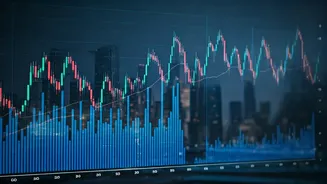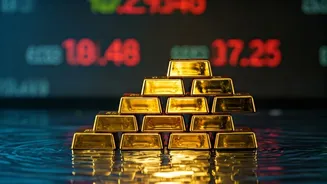Gold's Recent Dip
Gold, often seen as a safe investment, has recently seen a price drop. Various factors contribute to these price movements, and understanding them is crucial
for investors. These fluctuations are influenced by economic indicators, global events, and market sentiment. The price of gold doesn't move in a vacuum; it responds to a web of intertwined elements. Understanding these elements can help make informed decisions. Investors frequently watch the price of gold, especially when there are uncertain events taking place in the world. As a result, the dynamics of gold prices require a comprehensive understanding of the economy and global affairs.
Economic Influences Examined
Several economic factors can influence gold prices. For example, interest rate changes by central banks often play a pivotal role. When interest rates rise, the appeal of holding gold can decrease because it doesn't yield income like bonds. Inflation is another important element. Typically, gold is seen as a hedge against inflation. This means that, during times of rising inflation, the price of gold might increase. Moreover, the strength of the US dollar significantly affects gold prices, as gold is often priced in US dollars. When the dollar's value strengthens, gold can become more expensive for buyers using other currencies, potentially leading to lower demand and price decreases. Economic growth and the overall economic outlook are significant drivers, too. If the economy shows robust growth, investors might shift their focus to riskier assets, reducing the demand for gold and affecting its price.
Geopolitical Impact Explored
Geopolitical events frequently trigger volatility in the gold market. International conflicts and tensions often lead investors to seek safer assets, such as gold, thus increasing its price. Conversely, any reduction in global uncertainties might prompt investors to sell gold and invest in riskier, higher-yielding assets. Political instability in specific regions also plays a part. Significant events, such as elections or changes in government, can greatly influence the market. Economic sanctions and trade wars between major economies introduce additional volatility. Furthermore, major policy decisions made by large economies have the potential to indirectly affect the gold market. In short, any situation that impacts the perception of stability can alter gold prices.
Market Sentiment Matters
Investor sentiment is also a critical factor influencing gold prices. The overall feeling or mood of investors in the market can trigger buying or selling behaviors. Positive market sentiment can drive down gold prices as investors move funds into riskier assets. Contrarily, negative market sentiment, driven by economic concerns or geopolitical risks, can increase gold prices, as investors seek safe havens. Market analysts and media coverage significantly shape investor sentiment. Positive reports might foster confidence, while negative ones can spread fear. Technical analysis is also important: traders use past price movements and market data to predict future price trends. High trading volumes can also be a sign of increased interest in gold, either as a bullish indicator or, conversely, a bearish one. Thus, investor behavior shapes a large part of the gold market.















